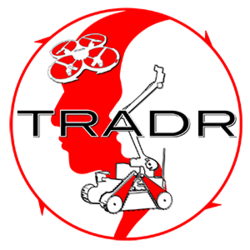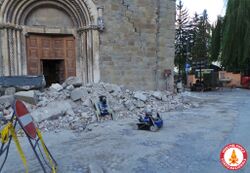Engineering:TRADR
TRADR: Long-Term Human-Robot Teaming for Robot Assisted Disaster Response is an integrated European research project funded by the EU FP7 Programme, in the area of robot-assisted disaster response.
Using a proven-in-practice user-centric design methodology, TRADR[1] develops novel science and technology for human-robot teams to assist in urban search and rescue disaster response efforts, which stretch over multiple sorties in missions that may take several days or weeks.
The novel technology makes the experience during robot-assisted response to an emergency persistent. Various kinds of robots collaborate with human team members to explore or search the disaster environment, and gather physical samples from the incident site. Throughout this collaborative effort, TRADR enables the team to gradually develop its understanding of the disaster area over multiple, possibly asynchronous sorties (persistent environment models), to improve team members’ understanding of how to work in the area (persistent multi-robot action models), and to improve team-work (persistent human-robot teaming). TRADR focuses on an industrial accident scenario, but the technology is equally applicable for using robots in other disaster, emergency and urban search and rescue (USAR) scenarios, such as earthquake relief, as the TRADR deployment of robots in Amatrice,[2][3] Italy, on September 1, 2016 shows.
Long-Term Human-Robot Teaming for Robot-Assisted Disaster Response TRADR began on November 1, 2013. It is an EU-funded 4-year Integrated Project (Nr. 609763) in the FP7 which builds on the research and experience of the NIFTi project.
Using a proven-in-practice user-centric design methodology, TRADR develops technology for human-robot teams to assist in disaster response efforts, over multiple missions: The novel challenge is how to make experience persistent.
Robots and the objectives
Five BlueBotics UGVs (code names: Charlie, Delta, Echo, Romeo, Tango) and two UAVs are used for collecting samples, detecting victims, mapping and analyzing the environment. The robots share local observation of the disaster area to build an interactive map which is then used y the end users (e.g. firefighters) to surveil the affected area.
In order to properly collect data over multiple mission TRADR robots gradually build persistent environmental model. The persistent models allow to represents dynamic environments, fusing multi-modal observations from different kinds of robots, possibly operating asynchronously across multiple sorties during a mission.
The persistent models are also used for multi-robot acting. TRADR aims to develop S&T for the gradual adaptation and grounding of individual- and multi-robot task-level planning and execution within and across sorties, to reflect experience with operating in the disaster area.
Most importantly, TRADR aims to build persistent models for human-robot teaming. The TRADR system is designed for the gradual adaptation of an individual robot's social skills to reflect experience with collaborating within a human robot team.
Scenarios
In the TRADR scenario, various kinds of robots collaborate with human team members to explore the environment, and gather physical samples. Throughout this collaborative effort, the team gradually develops its understanding of the disaster area over, multiple possibly asynchronous missions (persistent environment models), to improve team members’ understanding of how to work in the area (persistent multi-robot action models), and to improve team-work (persistent human-robot teaming).
The TRADR use cases involve response to a medium to large scale industrial accident by teams consisting of human rescuers and several robots (both ground and airborne).
TRADR missions ultimately stretch over several days in increasingly dynamic environments.
Partners
The TRADR consortium consists of 12 partners from 6 countries, among which there are 5 universities, 3 research institutes, one industry partner and three end-user organizations.
| Partner | Location | Function |
|---|---|---|
| DFKI | Germany | Coordinator |
| TU Delft | Netherlands | |
| Fraunhofer | Germany | Integration and testing |
| KTH | Sweden | Perception and Control |
| ETH | Switzerland | Mapping |
| CTU | Czech Republic | Perception and Control |
| La Sapienza University | Italy | Mapping and multi-robot collaboration |
| TNO | Netherlands | |
| Italian Vigili del Fuoco (VVF) | Italy | Firefighters: end-users and logistics |
| Rozenburg FF | Netherlands | Firefighters: end-users and logistics |
| Dortmund FF | Germany | Firefighters: end-users and logistics |
| Ascending Tech | Germany | UAVs |
Software and Datasets
TRADR released open source code for some of the implemented functionalities and several datasets.
References
- ↑ Kruijff-Korbayová, Ivana; Colas, Francis; Gianni, Mario; Pirri, Fiora; Greeff, Joachim de; Hindriks, Koen; Neerincx, Mark; Ögren, Petter et al. (2015-06-01). "TRADR Project: Long-Term Human-Robot Teaming for Robot Assisted Disaster Response" (in en). KI - Künstliche Intelligenz 29 (2): 193–201. doi:10.1007/s13218-015-0352-5. ISSN 0933-1875. https://hal.archives-ouvertes.fr/hal-01143484/file/2015_Kruijff_KI_TRADR.pdf.
- ↑ Kruijff-Korbayová, I.; Freda, L.; Gianni, M.; Ntouskos, V.; Hlaváč, V.; Kubelka, V.; Zimmermann, E.; Surmann, H. et al. (October 2016). Deployment of ground and aerial robots in earthquake-struck Amatrice in Italy (brief report). 278–279. doi:10.1109/SSRR.2016.7784314. ISBN 978-1-5090-4349-1. http://ieeexplore.ieee.org:80/document/7784314/?reload=true.
- ↑ "BBC Amatrice article". https://www.bbc.com/news/av/world-europe-37172460/in-the-heart-of-earthquake-hit-amatrice-in-italy.
External links




